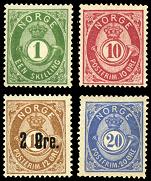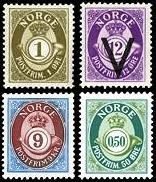  The
Posthorn-type stamps were designed by architect Andreas Friedrich
Wilhelm von Hanno in 1871 (18 years after the first trains were
running in Norway). With only slight alterations to the design and
inscription, re-engraving of the die, new printing methods, etc.,
the original design has remained unchanged until today. It is
commonly acknowledged as the world’s longest uninterrupted stamp
series. The design comprises the name of the country, the Royal
Crown and Posthorn (indicating official postal activity), and small
wheels and wings in each corner representing speedy transportation
of mail by rail [almost prophetic for air mail]. The wheels bespeak
the railways as carriers of the mails. The
Posthorn-type stamps were designed by architect Andreas Friedrich
Wilhelm von Hanno in 1871 (18 years after the first trains were
running in Norway). With only slight alterations to the design and
inscription, re-engraving of the die, new printing methods, etc.,
the original design has remained unchanged until today. It is
commonly acknowledged as the world’s longest uninterrupted stamp
series. The design comprises the name of the country, the Royal
Crown and Posthorn (indicating official postal activity), and small
wheels and wings in each corner representing speedy transportation
of mail by rail [almost prophetic for air mail]. The wheels bespeak
the railways as carriers of the mails.
An additional interesting railway correlation to the Posthorns is
that the designer of these stamps, *architect
A.F.W. von Hanno was a professional railway architect – he was
the architect of the station buildings of the first Norwegian
Railway (Hovedbanen)
and the first state railway in Norway (Kongsvinger
Railway), and together with a colleague, he designed the first
railway station in Oslo. It is known also that in the same year as
he created the stamp design (1871), von Hanno was working on a
draft/sketch design project for the second station in Oslo, the
Western Line Station.
By 2002, 153 main issues, in addition to seven stamps-on-stamps, had
been issued. Numerous design differences exist in vertical shading
lines, the size and shading of the posthorn, and in the corner wings
of all these definitive stamps issued over the years. Norway Post
has issued also much postal stationery franked with imprinted
posthorn stamps as indicia.
Survey of posthorn stamps
|
